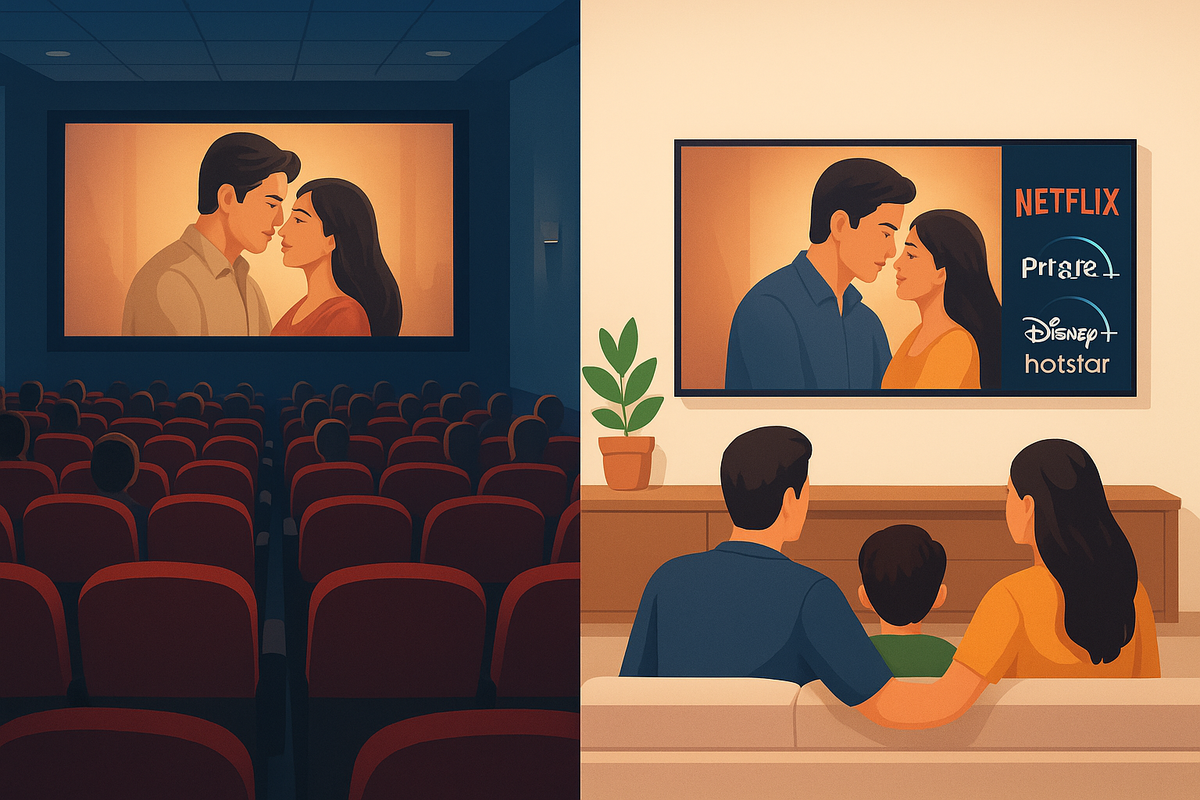Bollywood 2025: Why Streaming Platforms Are Beating Theatres
Bollywood in 2025 is undergoing a dramatic transformation as streaming platforms outpace theatres, reshaping audience habits, revenue models, and storytelling, while redefining stardom and global reach for India’s film industry.

Introduction: The Shift in Bollywood’s Heartbeat
For decades, Bollywood thrived on the magic of cinema halls. Friday releases, long ticket queues, and the collective experience of watching a blockbuster on the big screen defined Indian entertainment culture. Yet, by 2025, the rhythm of Bollywood has dramatically changed. Theatres, once the lifeline of the industry, are struggling to fill seats, while streaming platforms dominate conversations, profits, and creative directions.
This shift is not a passing trend it is a fundamental transformation in how Bollywood operates, consumes, and grows. The balance of power has tipped, and streaming platforms are now not only distribution hubs but also creative powerhouses.
The Pandemic Effect: Acceleration of a Pre-Existing Trend
The seeds of streaming dominance were planted long before COVID-19, but the pandemic acted as an accelerant. Lockdowns in 2020–21 forced audiences indoors, and platforms like Netflix, Amazon Prime Video, and Disney+ Hotstar became substitutes for theatres. Even after cinemas reopened, audiences had discovered the convenience of watching premieres from their living rooms.

By 2025, that habit is deeply entrenched. What was once an emergency solution has become the norm.
Changing Audience Habits
Bollywood’s core audience is no longer content with waiting weeks for a theatrical release. Viewers now demand instant access, binge-worthy storytelling, and flexibility. Three major changes stand out:
- On-Demand Culture: Audiences prefer watching films and shows on their own schedule, whether late at night or during commutes.
- Shorter Attention Spans: With reels, shorts, and quick content dominating phones, viewers have less patience for long cinema rituals.
- Diversity of Content: Streaming platforms offer everything—thrillers, rom-coms, regional cinema, docu-series. This diversity is something theatres cannot match.
In short, the consumer has evolved faster than the theatre ecosystem.
Economics of Theatres vs. Streaming
The financial logic of Bollywood has shifted in favor of streaming:
High Costs of Theatrical Release:
A film’s theatrical run involves expenses for distribution, marketing, and theatre partnerships. Even for big-budget films, the risk of box-office failure is high.
Assured Revenues from OTT Deals:
Streaming platforms often pay hefty sums upfront for exclusive rights. This guarantees profits to producers, regardless of box-office performance.

Global Reach:
- A Bollywood film on streaming immediately reaches millions of subscribers across continents an impossible feat for theatres, especially in tier-2 and tier-3 cities where cinema infrastructure is weak.
For producers, the economics is simple: why gamble in theatres when streaming ensures returns?
The Rise of Original OTT Content
Another reason streaming platforms are beating theatres is their investment in original content. OTT-exclusive Bollywood projects web series, anthologies, experimental films are thriving. In fact, some of Bollywood’s biggest stars now sign multi-film deals with streaming giants rather than focusing on theatrical blockbusters.

- Stars Go Digital: Big names like Shah Rukh Khan, Kareena Kapoor, and Ayushmann Khurrana have appeared in streaming-only projects, erasing the stigma once attached to “direct-to-OTT” releases.
- Creative Freedom: Directors enjoy more freedom on streaming platforms, experimenting with unconventional stories, darker themes, and longer narratives that would never get greenlit in a theatrical-first system.
- Fresh Talent: OTT has opened the door for new actors, writers, and filmmakers who might otherwise struggle in Bollywood’s star-driven theatre culture.
This democratization of Bollywood storytelling has shifted creative energy toward streaming.
The Decline of the “Friday Release” Culture
The ritual of eagerly awaiting Friday releases has lost its charm. In 2025:
- Fewer films release theatrically every week.
- Big-screen blockbusters are limited to franchises, mythological epics, or action spectacles with massive budgets.
- Small and mid-budget films rarely even attempt a theatrical release they go straight to OTT.
For the younger generation, a “Friday night binge” on a streaming platform has replaced the Friday night cinema outing.
Regional and Global Integration
Streaming platforms have blurred the boundaries between Bollywood and other industries:
- Regional Cinema Crossover: Tamil, Telugu, Malayalam, and Bengali films are available alongside Bollywood releases, often outperforming them. Audiences are now more language-agnostic, choosing stories over stars.
- Global Bollywood: Diaspora audiences no longer wait months for theatrical releases abroad. A film or series drops worldwide, creating simultaneous cultural conversations across continents.
- Subtitles and Dubbing: Streaming has normalized watching Bollywood films with subtitles or dubbed tracks, expanding their global footprint.
This integration has weakened the monopoly Bollywood theatres once held as the “default entertainment choice.”
Social Media and Streaming Synergy
Streaming content thrives in the age of viral clips, memes, and Twitter debates. Unlike theatres, where content fades after a few weeks, streaming shows and films enjoy long shelf lives thanks to online chatter.
- Clippable Moments: Emotional dialogues or shocking twists trend on reels and TikTok-style platforms.
- Fandom Communities: Shows build cult followings with dedicated fan theories, rewatch parties, and Reddit threads.
- Influencer Marketing: Streaming releases use social media creators to hype launches, reaching younger audiences in a way theatre promotions cannot.
Theatres, by contrast, struggle to sustain buzz once the initial release hype fades.
The Star System is Evolving
Bollywood once ran on the power of megastars. If Shah Rukh Khan, Salman Khan, or Aamir Khan released a film, theatres were guaranteed to fill. But by 2025, the star system has fractured:
- OTT Stars: Actors like Pankaj Tripathi, Radhika Apte, and Jaideep Ahlawat, once considered “supporting cast,” are now household names thanks to streaming.
- Content > Stardom: Audiences flock to gripping stories over star power. A well-written streaming series can outshine a theatrical blockbuster led by an A-lister.
- Global Crossovers: Indian actors are increasingly appearing in international projects via streaming collaborations, widening their appeal beyond Bollywood alone.
This redefinition of stardom favors OTT’s ecosystem more than theatres.
The Social Divide: Urban vs Rural
While streaming dominates urban India, theatres still hold sway in some rural and small-town markets where internet connectivity is weaker. However, even this gap is shrinking as affordable smartphones and cheaper data plans expand OTT reach. By 2025, even tier-2 and tier-3 cities are increasingly turning to streaming.
Theatres risk becoming a niche luxury experience, appealing primarily to metropolitan multiplex-goers for event films rather than everyday entertainment.
The Theatre Industry’s Counterattack
It would be unfair to say theatres are irrelevant. They are adapting, albeit slowly:
- Premium Experiences: Multiplexes are offering luxury recliners, gourmet food, and IMAX 3D to differentiate themselves from at-home viewing.
- Eventizing Cinema: Films are marketed as “cinematic events” rather than just releases, emphasizing the spectacle that can’t be replicated on a small screen.
- Hybrid Releases: Some producers experiment with simultaneous theatre + OTT releases, though this often sparks disputes.
Still, these strategies cater mostly to a shrinking urban elite. The mass audience remains loyal to streaming.
Bollywood’s New Creative Identity
Perhaps the biggest change is not economic but artistic. Bollywood of 2025 is no longer obsessed only with song-dance spectacles and love stories. Streaming platforms have nurtured bold narratives, including:
- Dark thrillers and true-crime stories.
- Socially conscious dramas exploring caste, gender, and politics.
- Sci-fi and fantasy experiments previously deemed too risky.
- Anthologies that bring multiple voices together in one project.
This new creative identity has given Bollywood global respect as a content powerhouse rather than just a masala factory.
Challenges for Streaming Platforms
While streaming platforms are beating theatres, the road ahead is not without hurdles:
- Content Overload: With so many releases, audiences often feel overwhelmed.
- Subscription Fatigue: Too many platforms mean people juggle logins or cancel subscriptions.
- Piracy: Despite global releases, piracy remains rampant.
- Theatre Nostalgia: A section of audiences still craves the magic of big-screen cinema.
Yet, none of these challenges are strong enough to reverse the dominance of OTT.
The Future: Coexistence, Not Extinction
By 2025, it’s clear streaming platforms have beaten theatres in terms of influence, revenue stability, and creative innovation. But this does not mean theatres will vanish. Instead, the future is one of coexistence:
- Theatres will become exclusive venues for mega-budget spectacles—historical dramas, superhero-style franchises, and musicals.
- Streaming platforms will dominate everyday entertainment with diverse, experimental, and globally accessible content.
- Audiences will choose between the two depending on mood, budget, and availability.
In other words, Bollywood has entered a hybrid age where streaming is the mainstay and theatres are the special event.
Conclusion: A New Era for Bollywood
Bollywood in 2025 is not weaker than before it is more dynamic, diverse, and global. Theatres may have lost their monopoly, but streaming platforms have unlocked opportunities that were unthinkable a decade ago.
From small-town actors finding fame to international audiences bingeing Indian content, streaming has democratized and expanded Bollywood’s reach. The story is no longer about Friday box-office collections but about global conversations, digital premieres, and cultural influence that stretches far beyond cinema halls.
The verdict is clear: streaming platforms are not just beating theatres—they are redefining Bollywood itself.
Sources:
- FICCI-EY Media & Entertainment Report (2024/2025)
- Covers revenue trends in Indian film & OTT industries.
- Website: ey.com
- PwC Global Entertainment & Media Outlook (2024–2028)
- Provides forecasts on OTT growth vs theatrical revenue.
- Website: pwc.com
- KPMG India Media and Entertainment Report
- Insights into digital-first audience behavior in India.
- Website: home.kpmg




